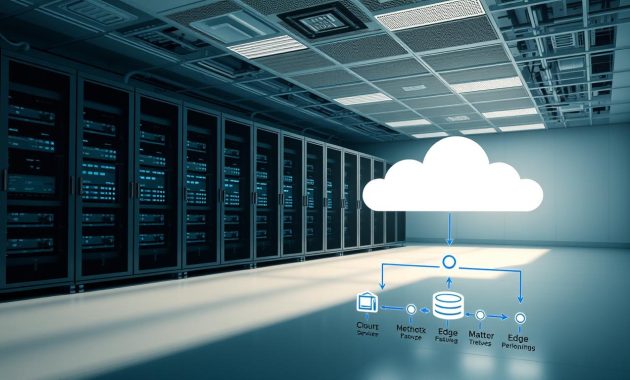Prepare to uncover the transformative potential of edge computing in conjunction with cloud server architectures. This synergy not only amplifies performance but also elevates operational efficiency. By integrating these technologies, a comprehensive digital framework emerges, tailored to fulfill your organizational objectives. The amalgamation of edge computing and cloud server architectures transcends the sum of their individual merits, forging a formidable synergy.
This synergy empowers the processing of data proximal to its origin, thereby diminishing latency and enhancing overall performance. As you delve into the realm of edge computing and cloud server architectures, you will gain insights into leveraging their synergy. This synergy is instrumental in driving innovation and growth within your organization. It enables the creation of a more streamlined and potent digital ecosystem, capitalizing on the advantages of both edge computing and cloud server architectures.
Understanding Edge Computing and Cloud Computing
In the realm of digital solutions, it is imperative to comprehend the nuances of edge computing and cloud computing. These technologies, though often discussed in tandem, cater to different needs. The essence of edge computing lies in its ability to process data proximal to its origin, thereby diminishing latency and augmenting the efficacy of real-time decision-making. Conversely, cloud computing’s definition encompasses the provision of computing services via the internet, facilitating scalability and adaptability.
The dichotomy between edge and cloud computing is rooted in their architectures and applications. Edge computing is paramount for scenarios necessitating immediate data processing, such as Internet of Things (IoT) devices or autonomous vehicles. In contrast, cloud computing is more appropriate for tasks demanding extensive data processing, such as data analytics or machine learning. Recognizing these distinctions is vital for crafting efficacious digital solutions.
The integration of edge computing with cloud computing fosters a synergy that amplifies the efficacy of digital solutions. This synergy enables the processing of data proximal to its source, thereby reducing latency and enhancing real-time decision-making capabilities. It also leverages the scalability and adaptability of cloud computing, creating a robust framework for digital solutions.
Benefits of Edge Computing in Cloud Architectures
Delving into the realm of edge computing within cloud architectures unveils a plethora of advantages that can significantly bolster your digital endeavors. The primary edge computing benefits encompass enhanced performance, reduced latency, and augmented data processing capabilities. By harnessing edge computing, you can refine your cloud architectures, thereby achieving superior results.
Edge computing’s prowess in diminishing latency stands as a cornerstone benefit. It facilitates data processing proximal to its origin, thereby ensuring reduced latency and expedited response times. This is crucial for applications necessitating immediate data processing, such as IoT devices or autonomous vehicles.

The pivotal advantages of edge computing in cloud architectures encompass:
- Enhanced performance and reduced latency
- Augmented data processing capabilities
- Decreased bandwidth expenditures
By integrating edge computing with cloud architectures, you forge a more streamlined and potent digital solution tailored to your precise requirements.
In the context of cloud architectures, edge computing emerges as a pivotal element in magnifying data processing capabilities and reducing latency. As you contemplate the advantages of edge computing, you will discern its capacity to optimize your cloud architectures and attain enhanced outcomes. Its capability to reduce latency and elevate performance positions edge computing as an indispensable facet of contemporary digital solutions.
Use Cases for Combining Edge and Cloud Technologies
Delving into the realm of edge computing and cloud technologies unveils a plethora of applications where their synergy can significantly enhance performance and efficiency. Edge computing use cases span across various sectors, offering substantial benefits in terms of real-time data processing. This capability not only diminishes latency but also elevates system responsiveness, a critical factor in today’s fast-paced digital landscape.
In the realm of IoT applications, edge computing’s role is pivotal, processing data proximal to its origin, thereby curtailing the volume of data transmitted to the cloud. This strategy is particularly advantageous in domains such as smart homes, industrial automation, and transportation systems. The integration with cloud technologies empowers access to a broad spectrum of services and tools, including data analytics, machine learning, storage, and security.
Several illustrative examples of the fusion of edge and cloud technologies include:
- Smart cities initiatives, where edge computing facilitates data processing from sensors and cameras, while cloud technologies are employed for data analysis and storage
- Industrial automation, where edge computing manages and monitors equipment, and cloud technologies are utilized for the analysis and optimization of production processes
- IoT applications, where edge computing processes data from devices, and cloud technologies are responsible for data analysis and storage
By comprehending the myriad use cases for the amalgamation of edge and cloud technologies, one can make strategic decisions to optimize business operations and maintain a competitive edge in the market.
Challenges in Integrating Edge with Cloud
When contemplating the integration of edge computing with cloud technologies, it is crucial to acknowledge the potential hurdles. Edge computing challenges, such as security concerns, pose a significant barrier. It is imperative that your cloud integration strategy effectively addresses these concerns.
The primary challenge lies in security concerns. Edge devices, often situated in remote or inaccessible locations, are inherently more susceptible to cyber threats. To counteract this vulnerability, the implementation of stringent security measures, including encryption and secure authentication protocols, is necessary to safeguard your data and devices.
Another formidable challenge is the complexity of data management. Integrating edge and cloud technologies necessitates the management and processing of vast amounts of data from diverse sources. This endeavor demands considerable resources and specialized expertise. To navigate this complexity, the utilization of cloud-based data management tools is advisable. These tools can facilitate the streamlining of data processing and analysis.

- Implementing robust security measures to protect your data and devices
- Using cloud-based data management tools to streamline your data processing and analysis
- Developing a comprehensive cloud integration strategy that addresses edge computing challenges
By recognizing these challenges and proactively addressing them, you can ensure a seamless integration of edge and cloud technologies. This approach will help you navigate the potential risks and obstacles effectively.
Future Trends in Edge and Cloud Computing
Delving into the realms of edge computing and cloud computing, it becomes imperative to grasp the evolving trends that will redefine these domains. Edge computing trends are witnessing a transformative shift, with a pronounced emphasis on edge AI. This innovation holds the potential to revolutionize numerous sectors.
Looking ahead, the integration of edge AI is poised to escalate, facilitating more refined and autonomous decision-making at the network’s periphery. This development will be pivotal in the realm of cloud computing, where the imperative for real-time data processing and analysis intensifies.
Key Drivers of Edge Computing Trends
- Advances in edge AI and machine learning
- Increasing demand for real-time data processing and analysis
- Growing need for enhanced security and reduced latency
As edge computing and cloud computing continue their trajectory of evolution, it is essential to remain abreast of the latest advancements and trends. By comprehending the future trajectory of these technologies, you can adeptly position your enterprise to capitalize on forthcoming opportunities and navigate impending challenges.
Best Practices for Implementing Edge and Cloud Solutions
Initiating the integration of edge computing best practices and cloud solutions necessitates adherence to a meticulously crafted set of guidelines. The first step involves a thorough assessment of your business needs and strategic objectives. This ensures that the chosen edge and cloud technologies are congruent with your specific requirements. Subsequently, the selection of appropriate technology partners is paramount, as they must offer comprehensive support and specialized expertise throughout the implementation phase. Finally, the establishment of a robust security framework is imperative to protect your data and guarantee the dependability of your edge and cloud infrastructure.
